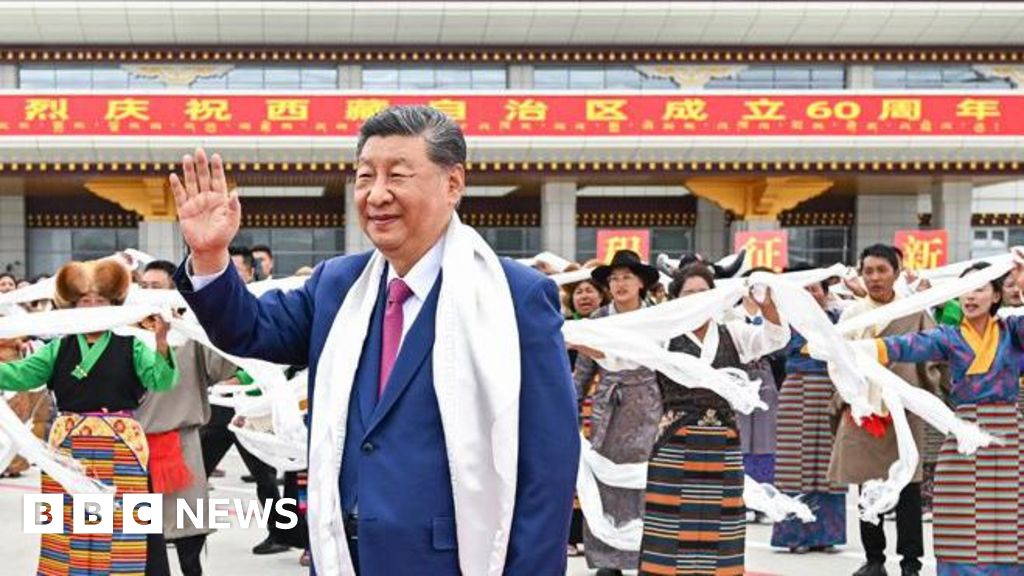China’s Xi touts unity and development in surprise Tibet visit

President Xi Jinping urged unity on a surprise visit to Tibet, appearing before 20,000 people to mark 60 years since China created the autonomous region after annexing it.
In what is only his second presidential visit to the tightly-controlled region, Xi praised the local government for “engaging in a thorough struggle against separatism” – a reference to decades-old Tibetan resistance to Beijing.
The visit to Lhasa, which sits at an altitude that could pose health problems for the 72-year-old, suggests a desire to stamp his authority over the region.
His published comments did not mention the Dalai Lama, the Tibetan spiritual leader who has been living in exile in India since he fled in 1959.
“To govern, stabilise and develop Tibet, the first thing is to maintain political stability, social stability, ethnic unity and religious harmony,” Xi said, according to an official summary of his speech.
His visit on Wednesday comes just two months after the Dalai Lama announced that his office, not China, would choose his successor. China’s leaders, however, claim that only they have the power to oversee that decision.
The 90-year-old has always advocated a “middle way” to resolve the status of Tibet – genuine self-rule within China – but Beijing regards him as a separatist.
China has long maintained that Tibetans are free to practice their faith, but that faith is also the source of a centuries-old identity which human rights groups say Beijing is slowly eroding.
When the BBC visited a Tibetan monastery in Sichuan province in June, monks claimed Tibetans were being denied human rights and that the Chinese Communist Party (CCP) continued to “oppress and persecute” them.
Beijing says the standard of living of people in Tibet has greatly improved under its rule and denies suppressing their human rights and freedom of expression.
The party established the Tibet Autonomous Region, or what it calls Xizang, in 1965, six years after a failed uprising against Chinese rule.
The Chinese president’s surprise visit was the lead story in every state media newspaper and TV bulletin on Thursday, where Xi’s tour of the Tibetan capital of Lhasa was portrayed as a celebration.
Photos published on the front pages showed him being greeted by Tibetan dancers and cheering crowds.
In his meeting with local authorities on Wednesday, which was also attended by senior CCP leaders, the Chinese president encouraged bilateral economic, cultural and personnel exchanges to and from Tibet, as well as well as the popularisation of a national common language and characters.
Xi also outlined the CCP’s vision for Tibet and highlighted what it views as the region’s four major tasks: ensuring stability, facilitating development, protecting the environment and strengthening borders, said Chinese state media.
The CCP’s policies have included new laws governing the education of Tibetan children, who must now attend state-run Chinese schools and learn Mandarin.
Xi also urged stronger regulation of “religious affairs” and a need to “guide Tibetan Buddhism to adapt to socialist society”.
The visit also comes a month after the CCP began construction in the region on what will be the world’s biggest dam. The dam – also known as the Motuo Hydropower Station – is located on the Yarlung Tsangpo river, which flows through the Tibetan plateau.
When completed, it will overtake the Three Gorges dam as the world’s largest, and could generate three times more energy.
Beijing says the scheme, costing an estimated 1.2tn yuan ($167bn; £125bn), will prioritise ecological protection and boost local prosperity.
But experts and officials have flagged concerns that the new dam would empower China to control or divert the trans-border Yarlung Tsangpo, which flows south into India’s Arunachal Pradesh and Assam states as well as Bangladesh, where it feeds into the Siang, Brahmaputra and Jamuna rivers.
Source link

